One of the biggest criticisms of Maurizio Sarri in the past was his unwillingness to change. Sarri would have preferred something to break rather than bending to its will.
At Chelsea, supporters didn’t really take to the Italian. His style was wonderful to watch at times, but the lack of defensive substance meant that the Blues were on the end of some hefty results, including a 6-0 drubbing at the hands of Manchester City and an embarrassing 4-0 defeat to Bournemouth.
During his short-lived stint at Juventus, this issue reared its ugly head once again. The Bianconeri conceded an average of 1.1 goals per game and boasted the second-worst record out of the top four teams during the 2019/20 campaign.
This carried over once more into this next job which was in Rome with Serie A giants Lazio. In fact, Sarri’s inability to set up a defence worsened.
By the end of the season, the Biancocelesti had one of the worst defensive records in Italy’s top-flight division and the second worst in the top ten, with an average of 1.53 goals conceded per game.
Lazio finished in a respectful fifth place last season, but improvements were desperately needed at the back if the side were to push for top four.
This season, Sarri’s men have the best defence in Serie A and are second in the table. The same manager, and pretty much the same group of players, but an astonishingly different turnaround. So, what happened?
This tactical analysis piece aims to identify how Sarri tweaked his tactics to ensure that Lazio are a different animal this season defensively.
*Note: This article was written before Lazio’s game versus Spezia on Friday night – 14/04/2023*
Statistical breakdown
Normally, in this section, we break down the different formations that a team have used. If Sarri had switched shape from the previous season, it would make sense to dedicate an entire section to explaining why he did and how it had positive effects on the team’s results. But he didn’t.
Sarri has always been a proud proponent of the 4-3-3 and this time it’s absolutely no different. The conventional structure – including variations of it (4-1-4-1 and 4-5-1) – has seen the light of day in 93 percent of Lazio’s games this season, with little to no variety.

What’s even more interesting is that Lazio’s statistics don’t make for great reading.
When looking at the side’s pizza chart from this season, comparing the Biancocelesti to all other sides in Serie A, you would be forgiven for believing that Sarri’s team were mid-table. But instead, they’re second only to champions-elect Napoli.
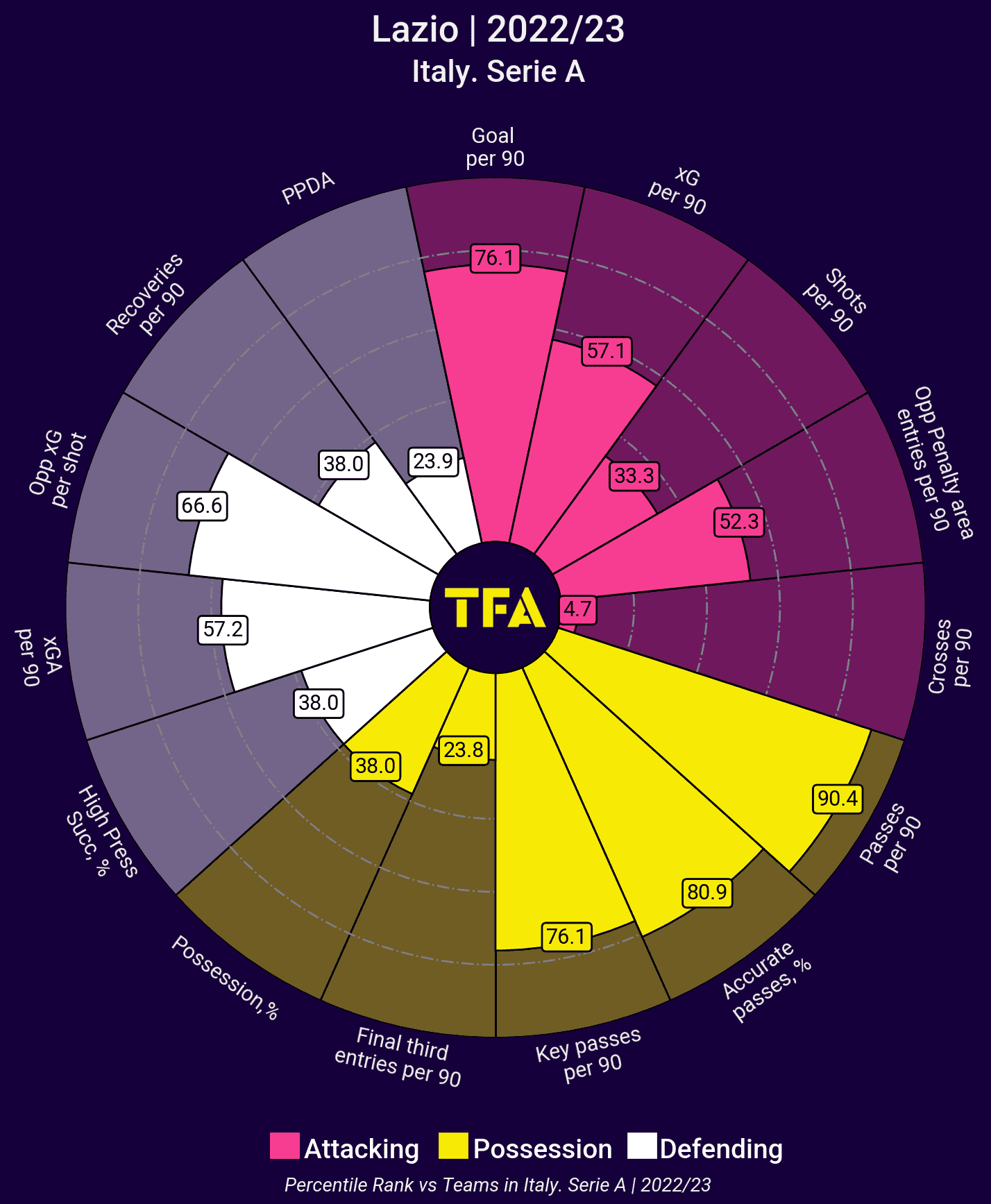
Since this article will be an analysis of Lazio’s defensive set-up, let’s focus on these specific metrics.
Lazio have ranked quite low on all metrics in comparison to the rest of the league given their position in the table. They don’t recover the ball that often, their PPDA is high, and their pressing isn’t that successful.
Lazio are a peculiar case study of a team that don’t look like they’re having too much joy from a defensive standpoint when analysing their statistics, but the reality is much different.
So, without wasting any more time, let’s look at Sarri’s tactical set-up out of possession which has helped Lazio to not ship goals at one end of the pitch.
The PPDA hypothesis
Quite often in modern analysis, particularly online with articles such as the scout report being written here, data is misconstrued. One of the Key Performance Indicators (KPIs) that are misinterpreted the most are Passes allowed Per Defensive Action (PPDA) in corroboration with challenge intensity.
PPDA is a simple metric. It measures how many passes a defending team allow the opposition to make before intervening with a defensive action. The lower the number, the fewer passes the attacking side make, hence the more pressure is being applied by the defending team.
Meanwhile, challenge intensity calculates how many defensive actions a team are making per minute of opposition possession. The higher the number, the more they are harrying the side in possession.
It is believed that this deadly duo together can form a perfect formula to identify how high a team presses. If the PPDA is high and challenge intensity is low, we can gather that a side defend very low down the pitch, and vice versa.
But Lazio are the antithesis to this hypothesis.
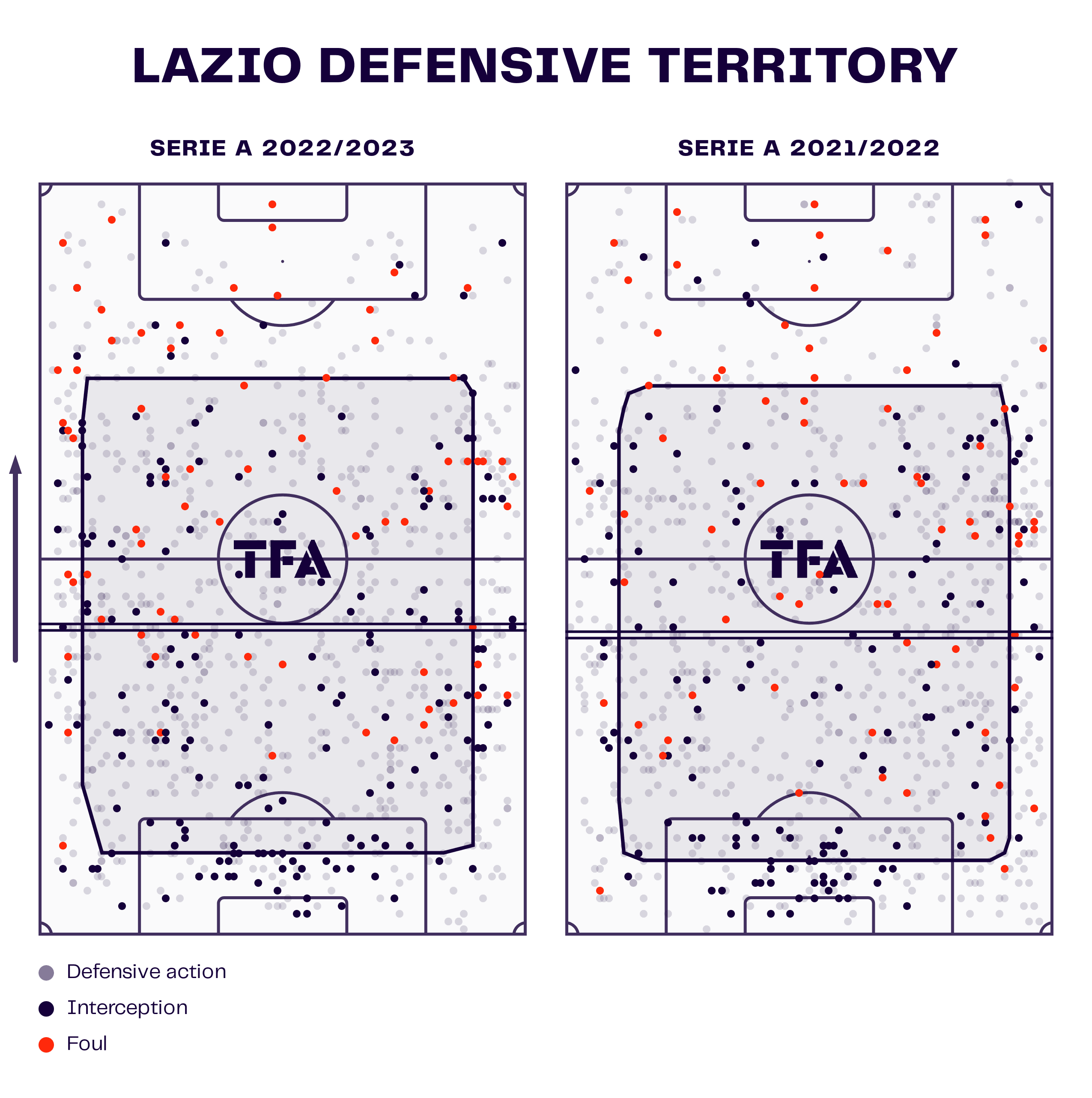
Across both seasons under Sarri, Lazio defended with a really high line for the most part. In fact, the average height of the defensive line across the two campaigns is practically identical.
However, the Biancocelesti have boasted quite a high PPDA number and a very low challenge intensity average.
This season, Lazio have registered a PPDA of 13.51 in Serie A which is the third-highest behind Salernitana and Sassuolo. It’s also the third-highest PPDA average in Europe’s top-five leagues.
Furthermore, Lazio’s current challenge intensity stands at 4.9 which is the sixth-lowest in Europe and the lowest in Italy’s top division.
The major flaw with this formula is that it only registers a defensive action if there is intent to win the ball.
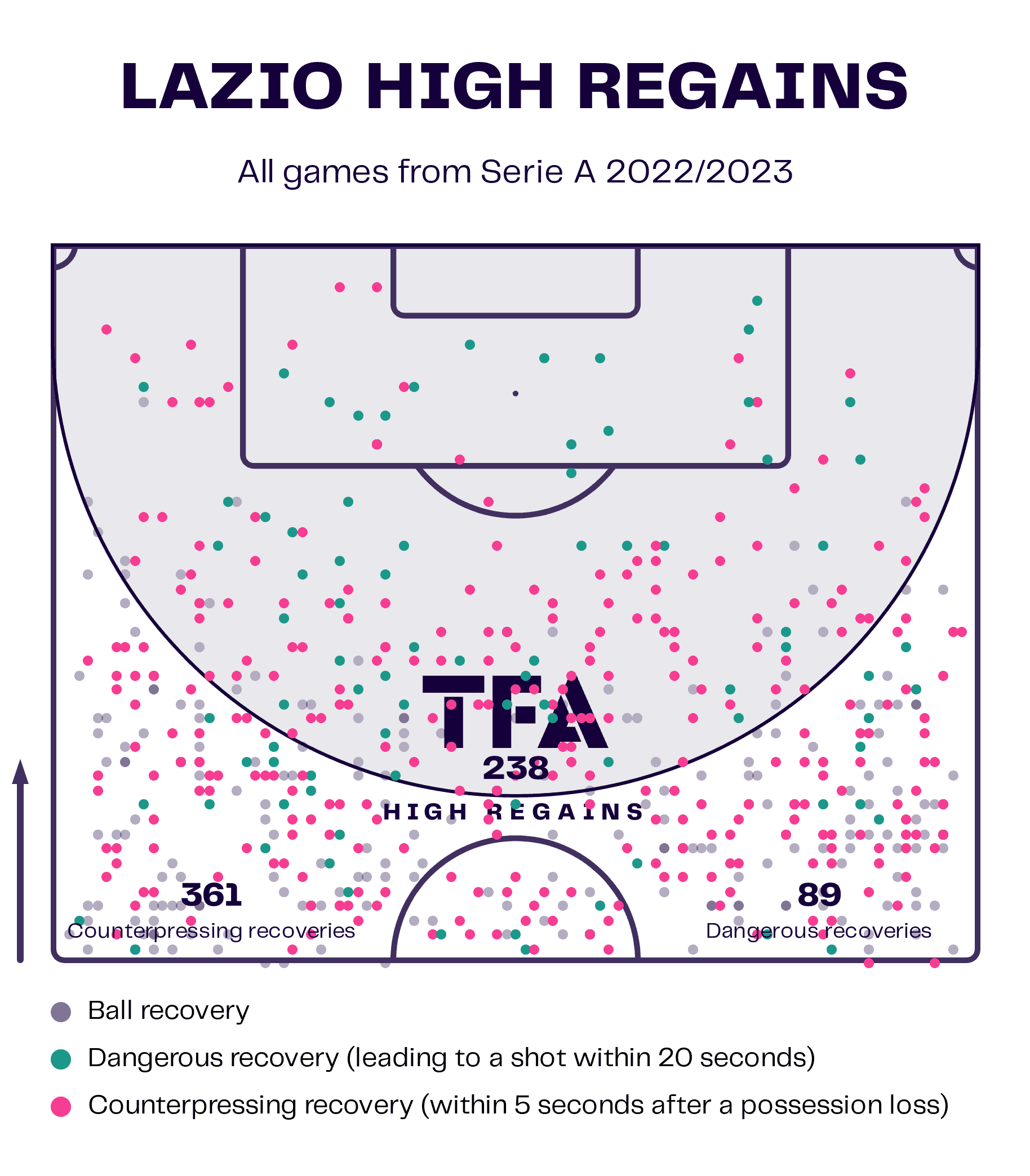
Now, we’re not saying that Lazio don’t intend on winning the ball when they press. As the previous data viz highlights, Sarri’s side have recorded 238 high regains in the opposition’s half, as well as 361 counterpressing recoveries and 89 dangerous recoveries.
But not many of these high regains or recoveries in the opposition’s half were because of intense pressure applied by the striker – primarily Ciro Immobile.
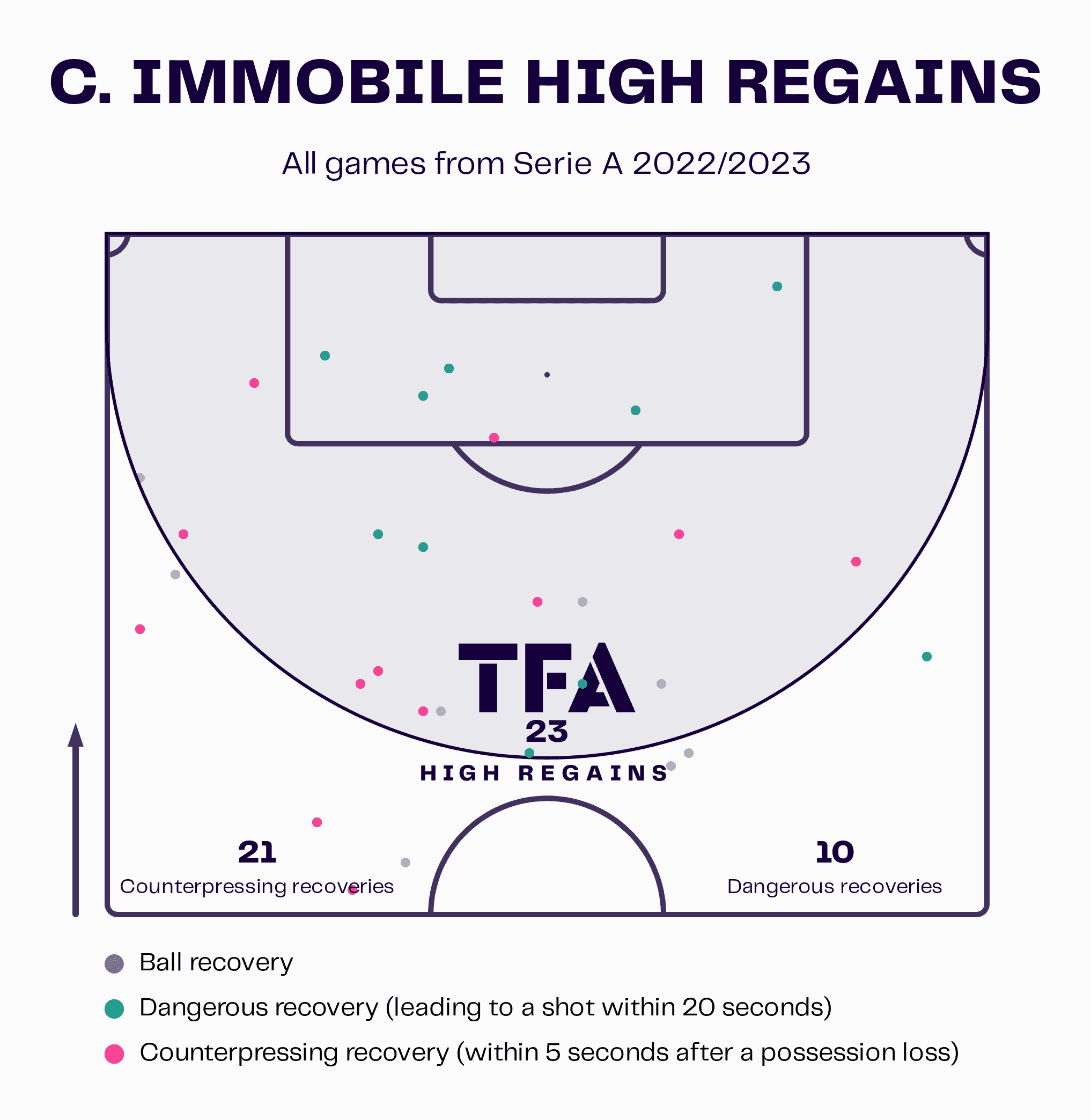
This is because, for the most part, when Lazio press, the intention is to force the ball into a specific area of the pitch to then recoup possession which is spearheaded by the number ‘9’ who constantly presses the opposition’s central defenders.
Nevertheless, the striker doesn’t do it on his own.
Hard-working midfield
As aforementioned, Lazio press but more so with the intention of forcing the opposition into specific areas of the pitch as opposed to doing so to win the ball as quickly as possible.
Jürgen Klopp’s Liverpool and Pep Guardiola’s Manchester City are teams that press high but with the aim of nicking possession close to the goal. Sarri doesn’t really subscribe to this methodology with Lazio, instead preferring a more containing approach.
The centre-forward leads the high block, pressing one centre-back at an angle to force them into a specific area. This can change from game to game depending on the strengths of the opposition.
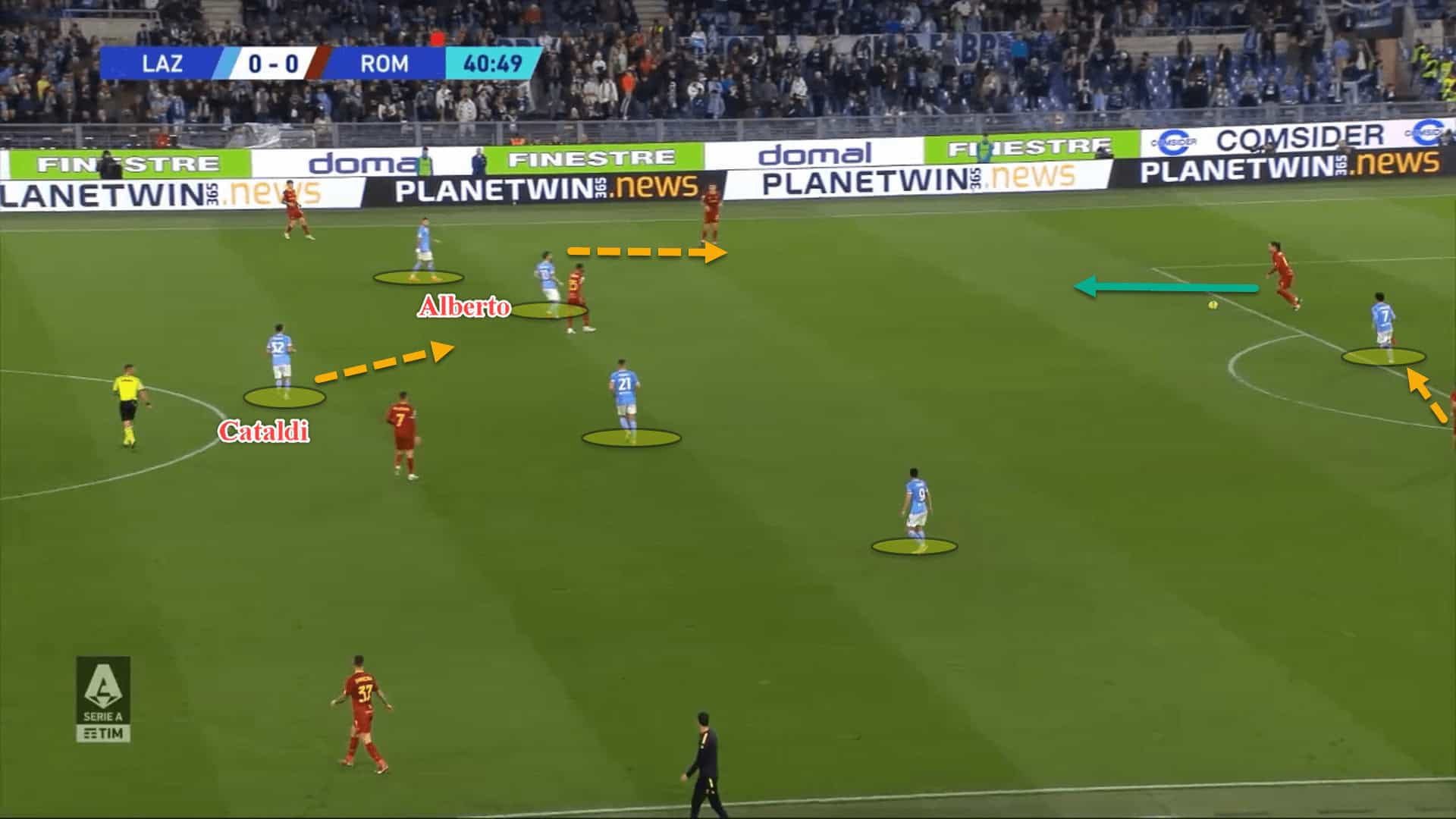
Here, Felipe Anderson, who led the line for Lazio in the Derby della Capitale, pressed Roma centre-back Chris Smalling while angling his pressure to ensure that the former Manchester United defender couldn’t play it back across his own penalty area.
A peculiar detail to note from this example is how little support Anderson received from the second line of pressure.
Lazio were defending in a 4-5-1 shape initially and the gap between the midfield and frontman was large. However, keep an eye on the body position of Luis Alberto and number ‘6’ Danilo Cataldi.
Alberto knew that if Smalling came any further with the ball, he would need to support Anderson and apply pressure to the English centre-back. Meanwhile, Cataldi is ready to replace Alberto in the second line and pick up Georginio Wijnaldum.
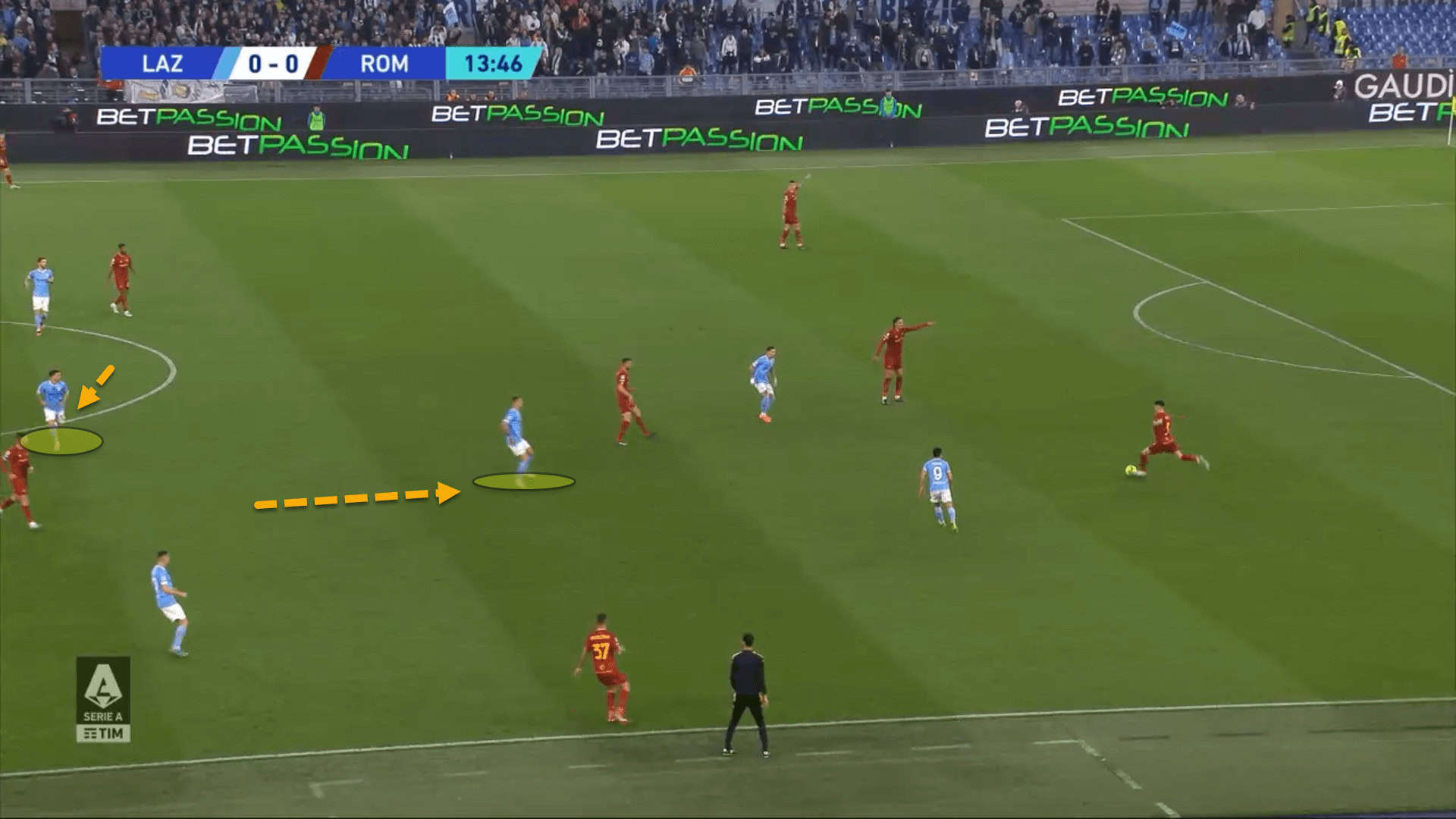
Sarri’s number ‘6’ is like a plumber out of possession, constantly plugging any holes to ensure that there is no leakage.
In the previous image, Sergej Milinković-Savić stepped out of the second line to apply pressure further up the pitch, leaving a gap in the midfield. As a result, Roma’s Lorenzo Pellegrini dropped into this vacant pocket but was quickly met by Cataldi who noticed the danger and slotted across.
Lazio’s formation is a base 4-5-1 but Sarri is keen for his wide central midfielders to constantly offer support to the centre-forward, particularly when defending in a mid-block, which causes the shape to change to a 4-4-2 regularly.
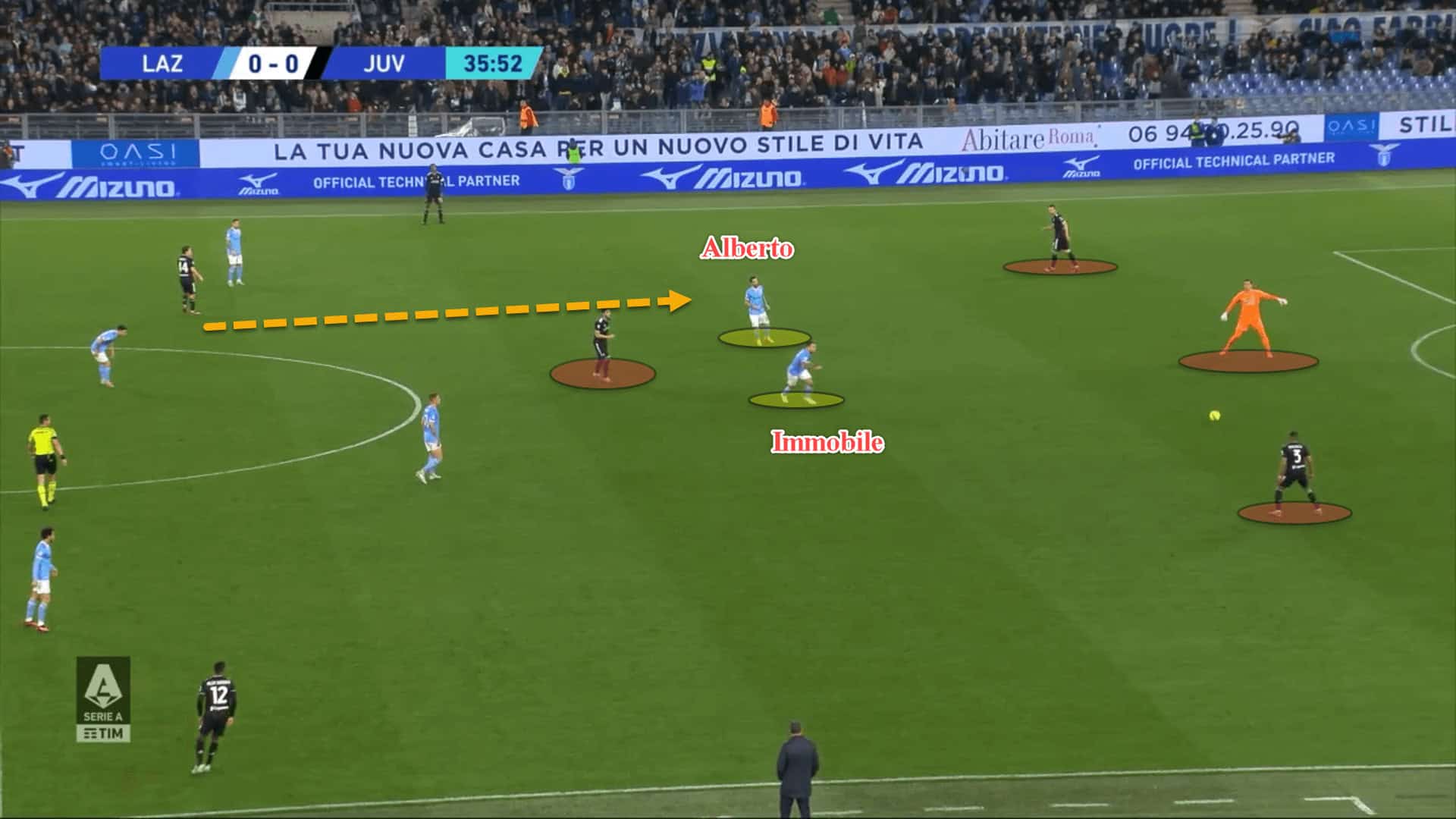
Lazio’s structure consistently fluctuates between a 4-5-1 and a 4-4-2 depending on the positioning of the central midfielders. The reason the central midfielders step up from the second line is so that the centre-forward is not overloaded by the opposition’s first attacking line.
In the previous example versus Juventus, Alberto pushed up alongside Immobile as the Bianconeri had a 3v1 + 1 with the goalkeeper and deepest midfielder. Immobile was pretty much useless without someone stepping forward to help him.
On occasion, even both central midfielders may step forward to press in the first line of pressure, with the wingers tucking closer inside to the number ‘6’, forming an oddly assembled 4-3-3.
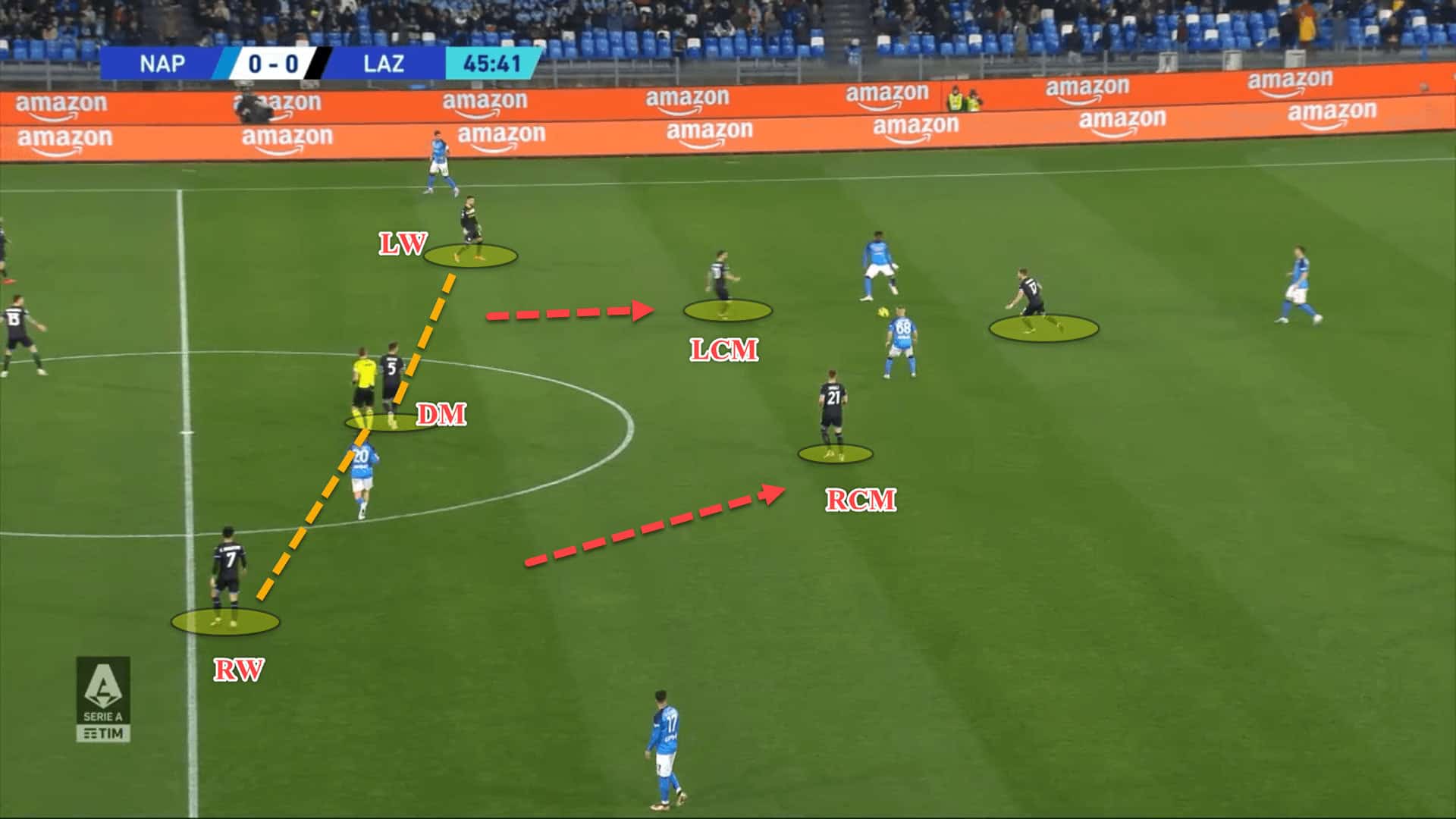
Here, Napoli dropped two of their three midfielders to the space in front of their own backline and so Lazio matched them to ensure that Immobile wasn’t outnumbered in this area.
It’s quite fun seeing the functionality of Lazio’s midfield out of possession under Sarri as the wide central midfielders jump in and out of the second line and the single pivot plugs any holes behind them.
The winger also provides an important function when Lazio are defending in a settled block. If the ball is on the left and Lazio have tilted to the ball-side to defend the flanks, the furthest winger will push up.
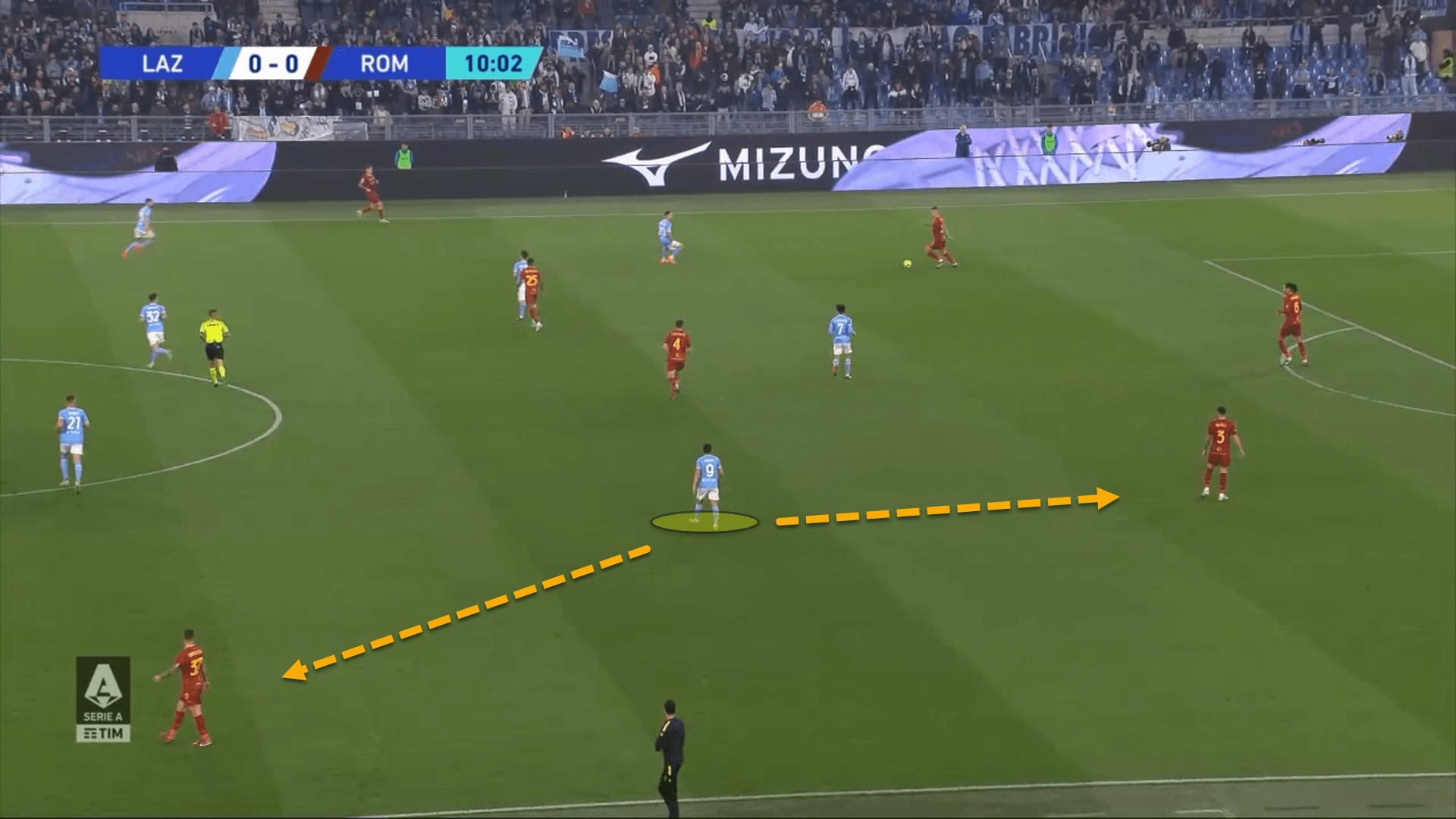
The objective here is to prevent the attacking team from switching the play. In this example, if Roma circulate the ball across to the furthest centre-back, Pedro is ready to jump him to potentially win the ball in a dangerous position.
Likewise, the centre-forward is given the important task of pressing backward. Pressing backward can be just as effective as pressing at an angle as the player is coming from the ball-carrier’s blindside.
Immobile, or whomever else may occupy that position, works tremendously hard to help the rest of the block if an opposition player is advancing forward.

Look at this example. Lazio are defending in a very compact 4-5-1 defensive low block. The midfield and backline are not in any immediate danger but Immobile recognises the opportunity to help out his teammates and nick possession and so presses backward to win the ball from the Napoli attacker’s blindside.
The backline
While analysing Lazio’s excellent defensive record this season and the tactics that have gone into achieving this, we would be doing a disservice to you all if we didn’t discuss the backline.
“The goalie is the first attacker, and the striker is the first defender,” is a famous line by the late, great Johan Cruijff when he described his playing style.
In the modern game, this is particularly common. The striker leads the press, and the goalkeeper builds the attack. Defenders no longer defend in isolation. It’s a collective effort from the team but the backline still has a major role in keeping goals out at the other end.
Lazio are faced with a lot of channel balls. Since they are so proactive in the middle of the park, it can be quite difficult to play through the Biancocelesti. Hence, many teams opt to play over them.
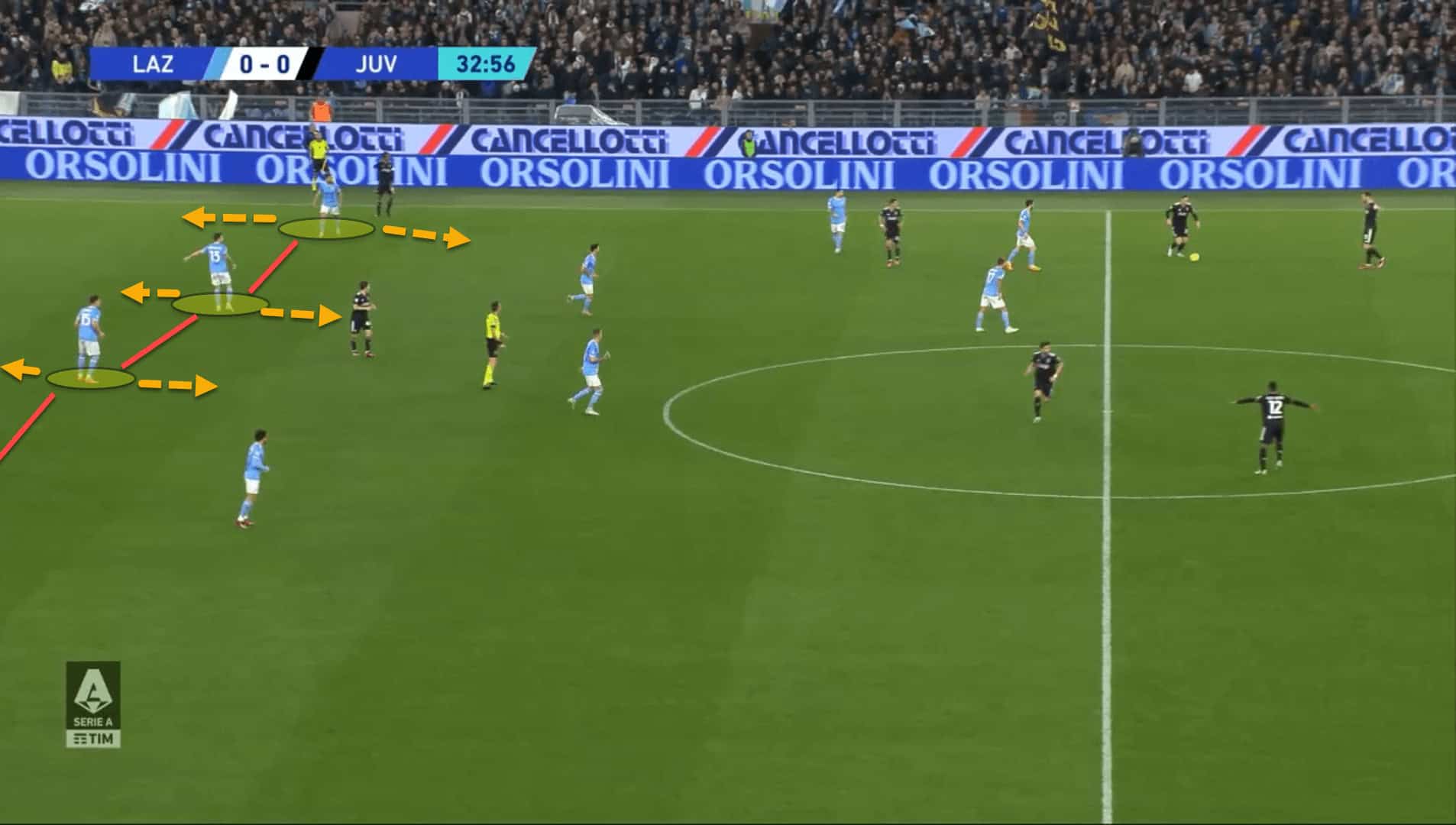
Nonetheless, the defenders are normally ready to drop back, always reading the situation in front of them and positioning their bodies side-on.
A sideways stance allows a defender to be ready to drop back and push forward and is the optimal body orientation for chasing balls into the channels.
When defending the channels, it is merely a case of winning defensive duels. Lazio have won 59 percent of their defensive duels on average this season and so are quite comfortable in 1v1 situations.
The backline work impeccably in unison, even from aerial balls. One steps out to challenge in the duel while the other three drop off a few yards and squeeze closer together in case the ball is flicked on to a runner in behind.
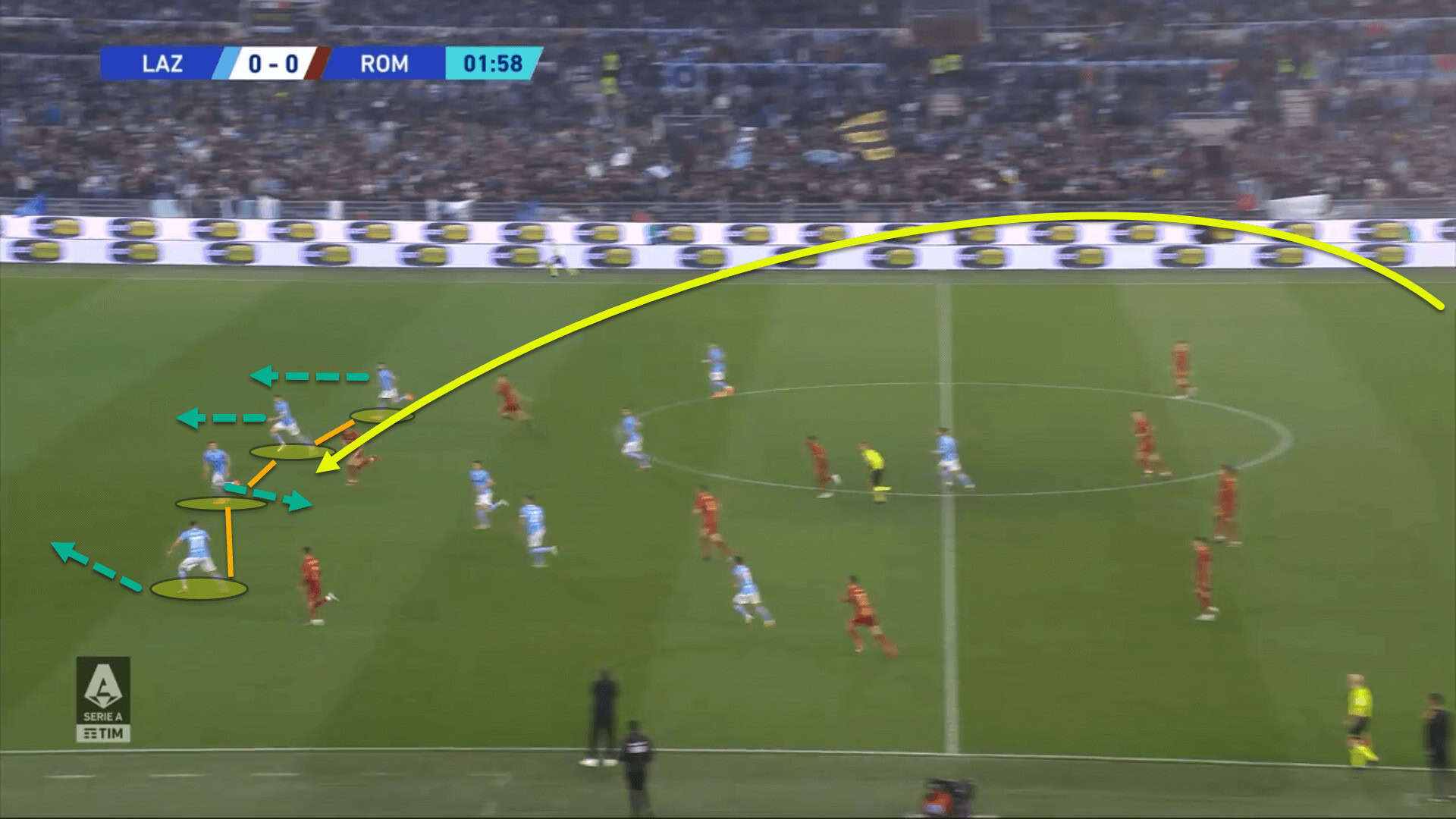
It is this organisation in every facet of the defensive phase that has helped Lazio so much this season.
These minute details may seem tedious, but Sarri’s men are the most organised team in Italy right now from a defensive standpoint which is a massive credit to the coaching staff.
Role of the goalkeeper
While we are giving huge credit to the manager and his staff for their ability to structure Lazio all over the park, denying the role of the goalkeeper would be nonsensical.
This season, in Serie A alone, Lazio have conceded an xG of 41.47 which is roughly around the league’s average. In reality, the Biancocelesti have conceded just 20 goals in Italy’s top-flight. This is an underperformance of more than double the amount that has been shipped which is truly unbelievable.
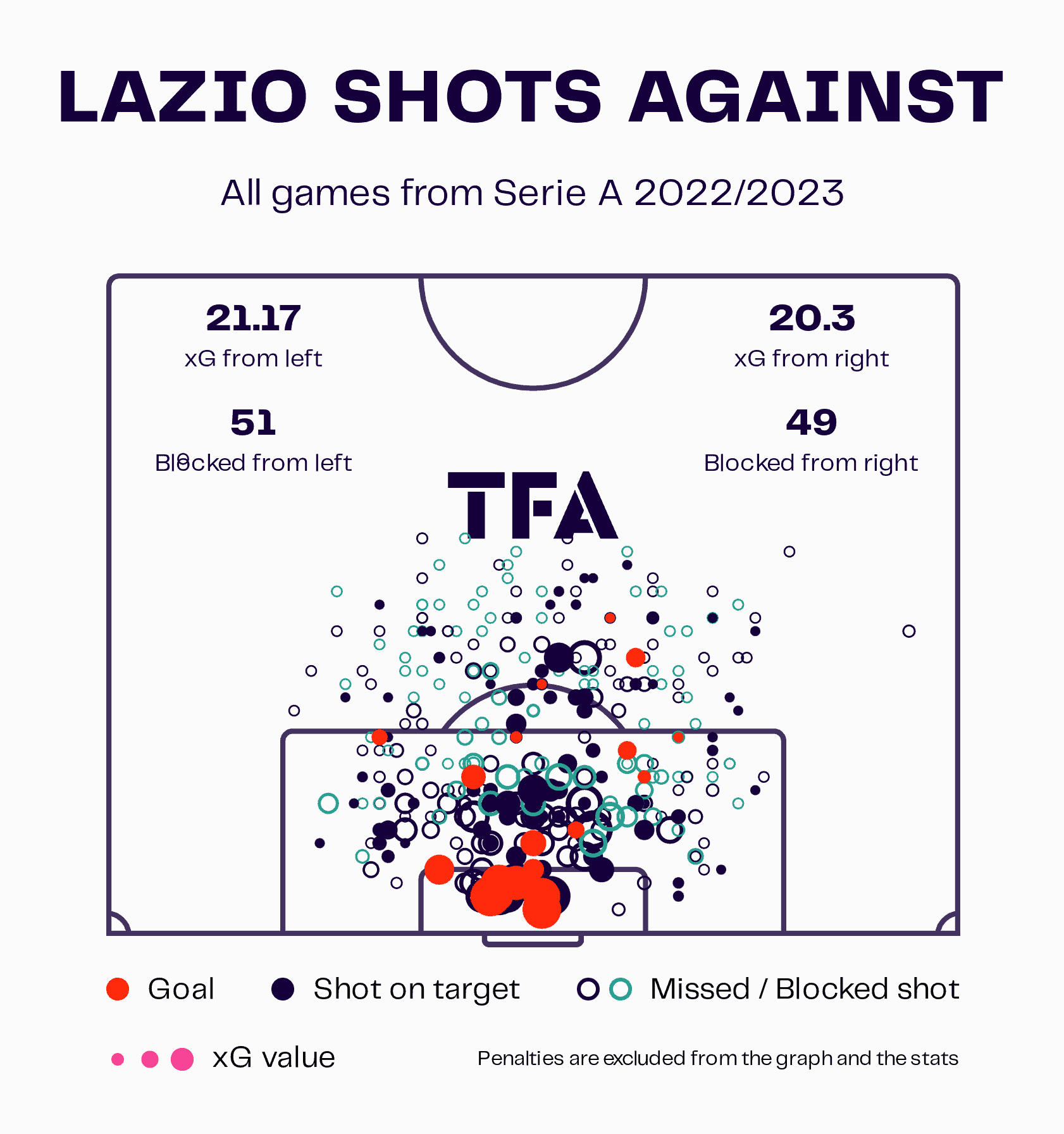
Lazio have conceded an xGA of 1.37 this season on average per game while conceding a real tally of just 0.69 per game in Serie A. Sarri’s side are also allowing 10.78 shots per 90 which is the ninth-highest in the league.
Furthermore, opposition teams are averaging 0.114 xG per shot against Lazio which is one of the highest xG per shot rates in Serie A in the current campaign, feeding the hefty xG they have shipped.
But can we put this down merely to poor finishing from Lazio’s opponents? Not exactly.
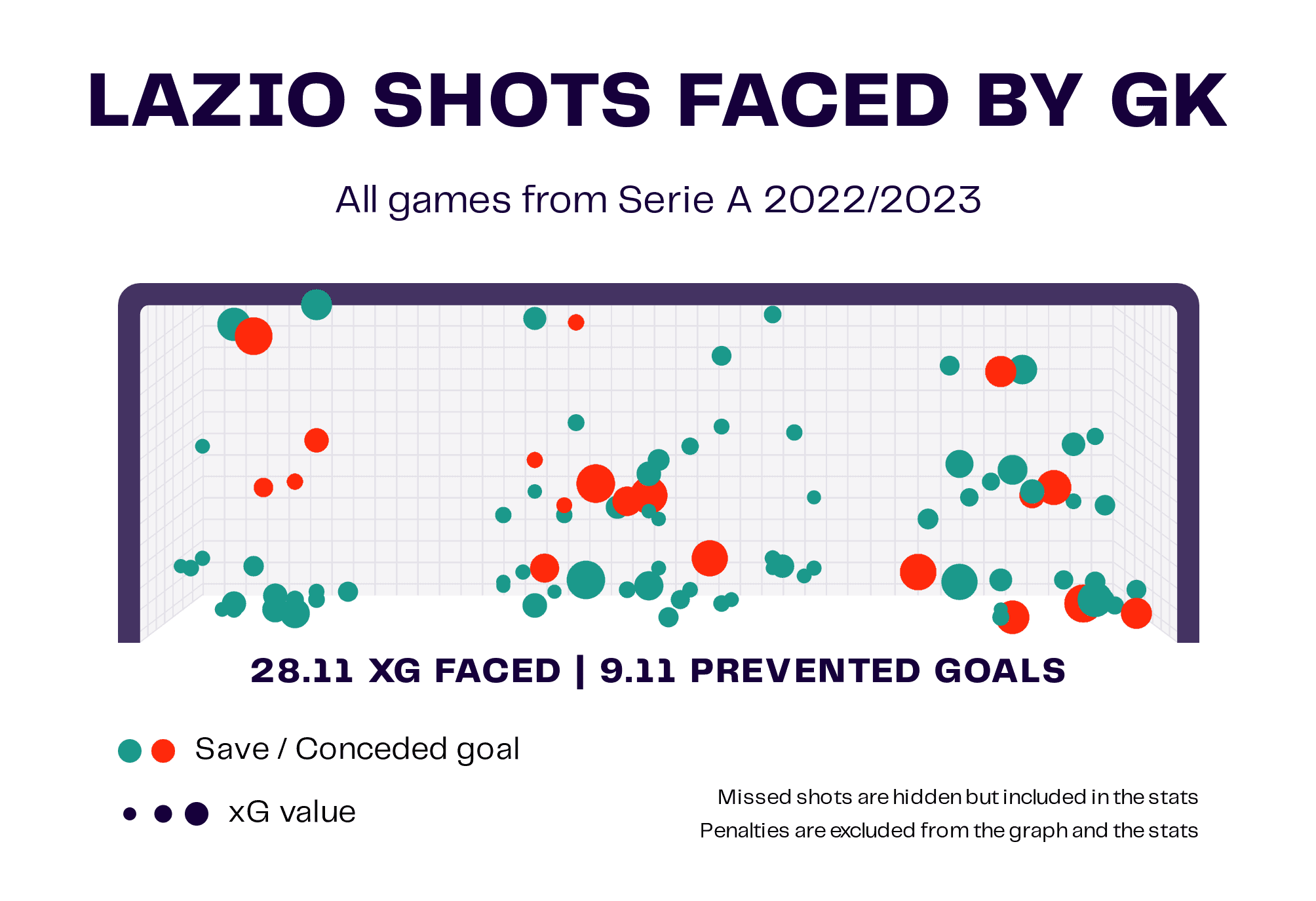
Lazio’s goalkeeper has been performing ridiculously well this season and has prevented 9.11 goals in Serie A alone. Ivan Provedel has been the main man between the sticks and so should be getting huge plaudits for his performances in Rome.
When comparing Lazio’s goalkeeping performances this season to the previous campaign, it’s quite telling that Provedel is one of the key reasons behind Lazio’s newfound defensive success.
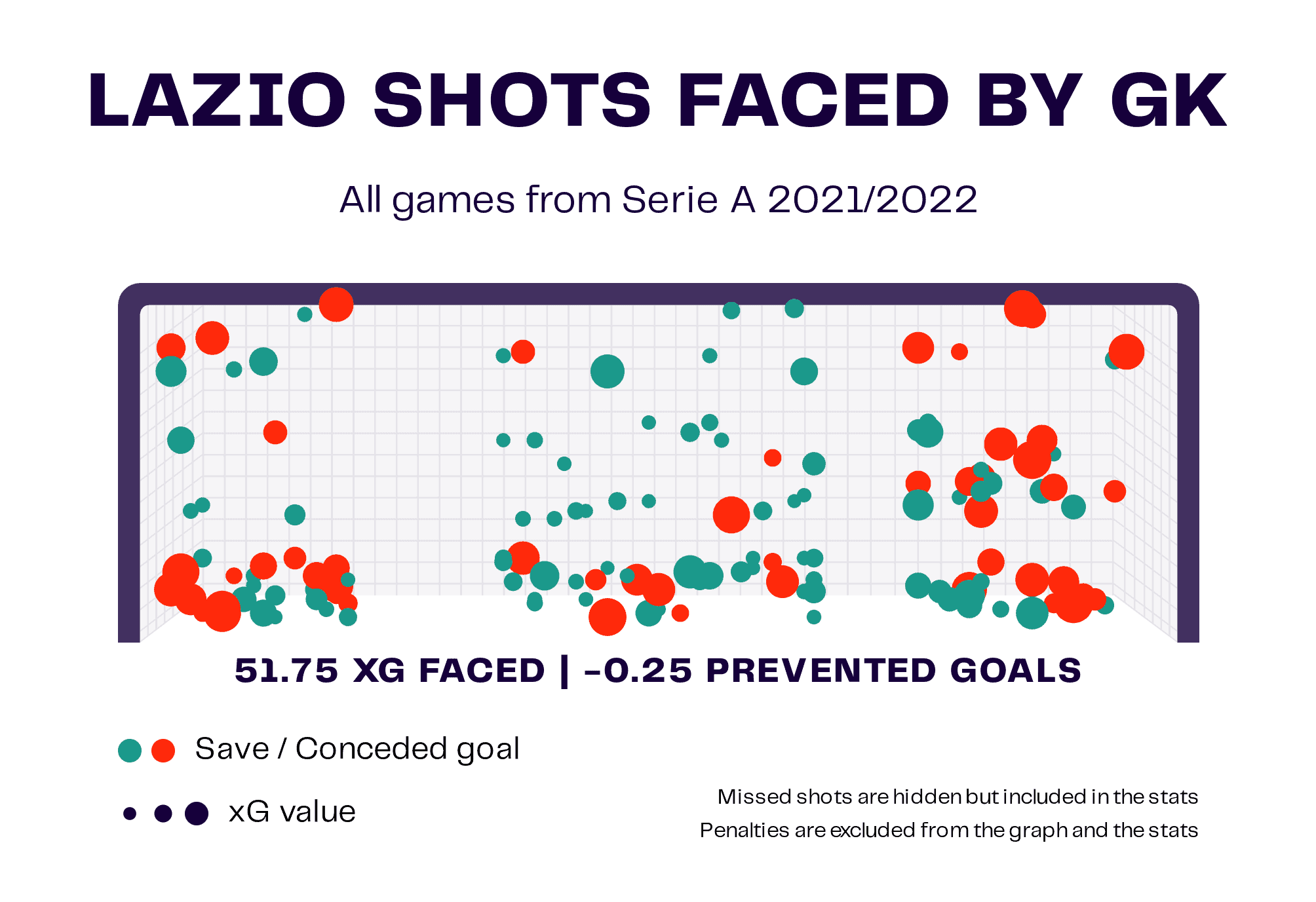
In fact, Lazio’s keepers hindered them last season and cost the team more goals than they helped to prevent.
Of course, the team are far more organised this season under Sarri, but a lot of credit should be handed to the man between the posts too.
Conclusion
Lazio are a peculiar case study this season. The side’s expected statistics don’t match their real numbers from a defensive standpoint and perhaps they’re performing a little better than they should be, with a dash of luck involved.
However, the Biancocelesti are an example of why football is so beautiful and a reminder to everyone that the sport is not merely just a science in the modern age as it’s sometimes made out to be.






Comments